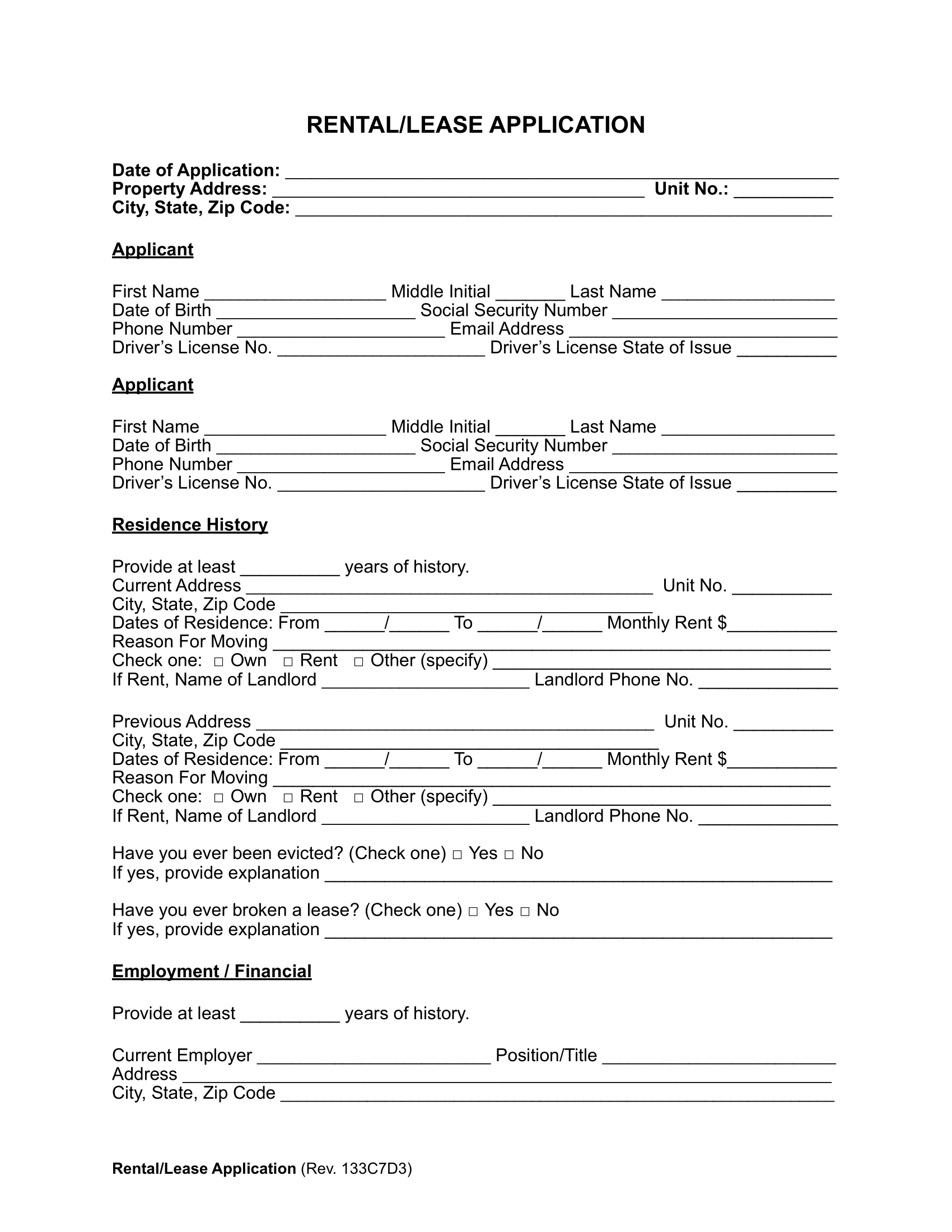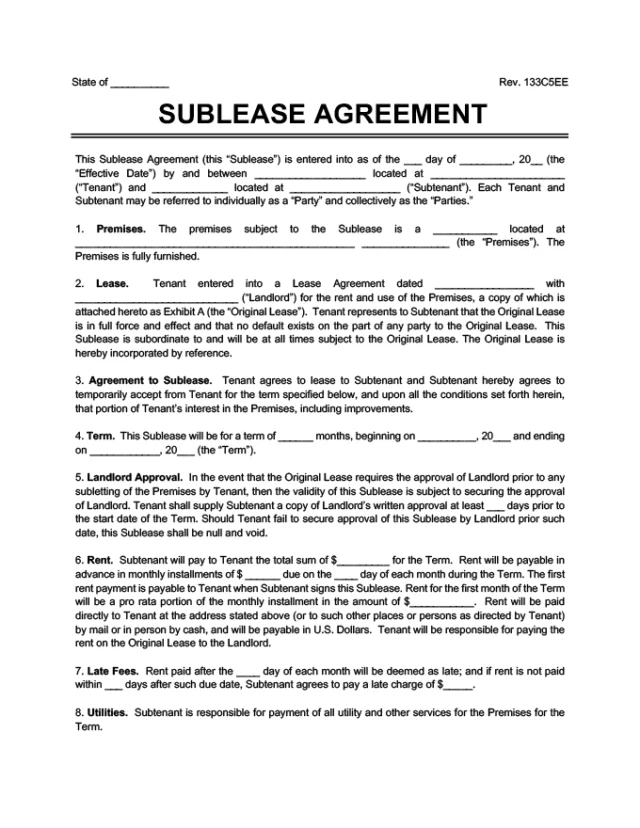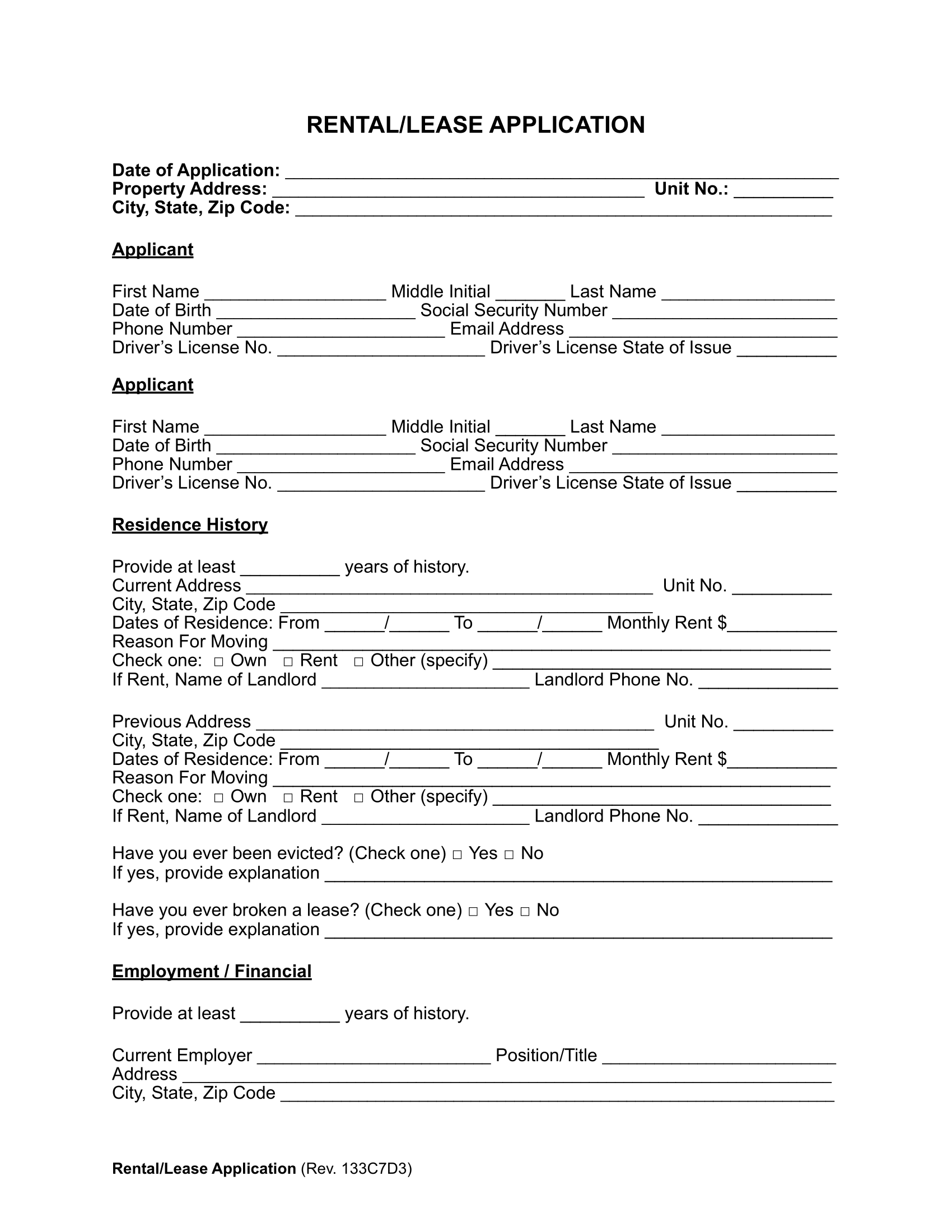What Is a Rental Application?
A rental application is a form that the landlord provides to potential tenants to gather information. The tenant fills out their income, employment, and rental history. As a landlord, you can use their responses to select the best tenant for your property and make renting out your space easier.
Our step-by-step template guides you through the process. Use our form to create a free and effective rental application.
Rental Application Forms by State
State laws and requirements may influence the format and contents of your rental application. View our state-specific forms to ensure compliance no matter where your property is located.
- Alabama
- Alaska
- Arizona
- Arkansas
- California
- Colorado
- Connecticut
- Delaware
- District of Columbia
- Florida
- Georgia
- Hawaii
- Idaho
- Illinois
- Indiana
- Iowa
- Kansas
- Kentucky
- Louisiana
- Maine
- Maryland
- Massachusetts
- Michigan
- Minnesota
- Mississippi
- Missouri
- Montana
- Nebraska
- Nevada
- New Hampshire
- New Jersey
- New Mexico
- New York
- North Carolina
- North Dakota
- Ohio
- Oklahoma
- Oregon
- Pennsylvania
- Rhode Island
- South Carolina
- South Dakota
- Tennessee
- Texas
- Utah
- Vermont
- Virginia
- Washington
- West Virginia
- Wisconsin
- Wyoming
Why Should You Use a Rental Application?
As a landlord, a rental application serves many purposes. Using this form ensures you can compare potential tenants and find the best renter for your property. Ultimately, you should use a rental property to protect your financial interests and your rental space. The benefits of using a rental application form include:
- Protecting your property: A tenant’s application shows their reliability and provides information about how they treated their previous rentals. Selecting a tenant with a good rental history ensures they will care for your property.
- Ensuring your tenant pays: Verifying a tenant’s employment and income ensures they can make regular payments. Additionally, credit score information confirms their ability to pay on time.
- Finding the right fit: With a rental application, you learn about the tenant’s habits and lifestyle. You may ask their previous landlords about noise complaints, behaviors, and reliability to find a good fit for your property.
How to Screen Tenants Using a Rental Application
A rental application is a key part of the tenant screening process. It provides you with the information necessary to verify and evaluate your potential tenants. Follow the steps below to screen tenants with a rental application.
1. Gather Candidate Responses
The first step in screening tenants is to send out the rental application and gather their responses. When sending the application, ensure you provide a Fair Credit Reporting Act (FCRA) Disclosure. This lets them know you plan to check and use their credit report information in your decision-making process.
In addition, collect the application fee. This fee covers some of the costs associated with processing applications and verifications. Some states limit the amount landlords can charge for a rental application. View the table below for state-specific regulations and maximum fees.
| State | Maximum App Fee ($) | Laws |
|---|---|---|
| Alabama | No limit | No statute |
| Alaska | No limit | Landlord-Tenant Handbook |
| Arizona | No limit | ARS 33-1321(B) |
| Arkansas | No limit | No statute |
| California | Actual cost of screening processes; no more than $30.00 | Cal. Civ. Code § 1950.6 |
2. Verify the Applicant’s Identity
As part of the application process, ask each candidate to supply a copy of their government-issued photo ID. This can include their driver’s license or passport. This ensures that the name and information provided on the application are correct. Verifying their identities can help you avoid common tenant scams. Also, ask tenants to provide any other legal names they’ve used in the past, as this may help with credit and background checks.
3. Perform a Credit Check
A credit check gives you an idea of the applicant’s credit score, debt history, and payment records. This information provides insight into the tenant’s ability to make regular, on-time rent payments. Ask for the applicant’s social security number and have them provide a written consent for a credit check. With the proper information and consent, you can perform a credit check through online services, such as RentPrep.
4. Check Their Rental History
In addition to checking credit history, verify a tenant’s rental history. On the application, ask for contact information from their most recent landlords. You can reach out to these landlords to get an idea of the applicant’s past behaviors, payments, and treatment of the property. Consider asking the following questions:
- Did this tenant have any issues or missed payments?
- Was the tenant evicted? What was the reason for the eviction?
- Did the neighbors have any complaints about the tenant?
- What condition did they leave the property in?
5. Verify Employment and Income
Double-check the tenant’s employment and income information. You can verify this information by requesting recent pay stubs or W-2 tax forms. Also, consider reaching out to their listed employer and asking them to complete an employment verification form. For self-employed applicants, ask for a copy of their 1040 tax forms as income documentation.
Ensure that their reported income meets any requirements for your rental property. Generally, landlords require a monthly income equal to three times the monthly rent.
6. Check the Tenant’s Legal Records
In addition to checking their identity, financials, and rental history, look into the candidate’s legal records. Start by looking at the National Sex Offender Public Website. You can also use online services, such as court databases, to check for past evictions or arrests. Make sure to obtain a background check authorization form from the tenant before starting your screening.
7. Choose Your Desired Tenant
After you’ve screened the tenants, compile the information and evaluate your choices. Research which credit score ranges are good for renters, and look for common green flags on rental applications. Your desired or minimum credit score for tenants can vary depending on the location, size, and price of your property. On average, renters’ credit scores fall into one of these ranges:
- 670+: 670 or more is a very good credit score. Candidates with this score are at or above the national average.
- 601 to 660: This is regarded as a fair score. Most tenants may be in this range, especially since most renters don’t have a mortgage history to boost their scores.
- 300 to 580: Often, candidates in this category are seen as having financial challenges or trouble making payments.
Pick your desired renter and send an approval letter. You can also send rejection letters to any applicants who weren’t approved. After you send the approval, collect your security deposit. You may also provide information about next steps, such as arranging utilities, setting a move-in date, and discussing landlord access. Once you’ve settled the necessary terms and paperwork, both parties can sign the lease agreement.
Fair Housing Laws
When selecting your desired tenant, remember to follow the protections provided by the Fair Housing Act. This act states that landlords cannot discriminate against tenants or offer favorable treatment to one potential tenant over another based on any of the following factors:
- Race
- Color
- National Origin
- Religion
- Sex
- Familial Status
- Disability
Other protections include the Americans with Disability Act (ADA), which requires landlords to make and allow reasonable accommodations or modifications for tenants with disabilities. In addition, the Department of Housing and Urban Development has stated that discrimination based on gender expression and sexual orientation is prohibited as part of sex discrimination.
Each state may have its own state-level fair housing guidelines. Check for specific guidelines and protections in the state where your rental property is located.
Sample Rental Application Form
View our free rental application form sample for the proper formatting and information. Our legally compliant forms are available to download in Word and PDF formats.
How Long Does a Rental Application Take?
On average, the rental application and screening process takes one to three business days to process. You may have to wait for responses from employers, prior landlords, and references. As a landlord, make sure your rental application includes all of the necessary information from the beginning, so there’s less back-and-forth with the applicant.






